It’s possible that I shall make an ass of myself. But in that case one can always get out of it with a little dialectic. I have, of course, so worded my proposition as to be right either way (K.Marx, Letter to F.Engels on the Indian Mutiny)
Friday, June 26, 2020
Wednesday, October 11, 2023
CBC
Wed, October 11, 2023
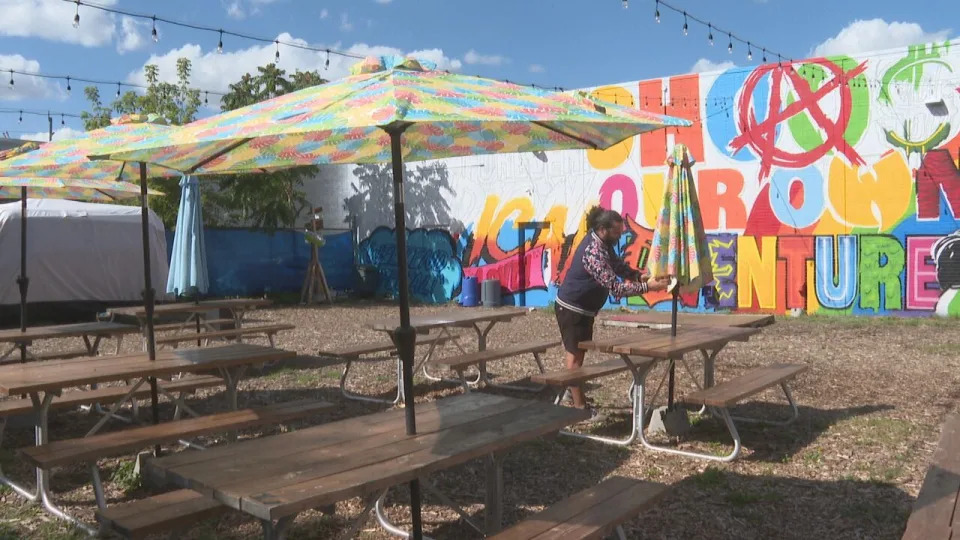
At its height, the Windsor Craft Beer Festival attracted thousands of thirsty brew enthusiasts, beckoned by the promise of hoppy IPAs and other artisanal suds.
But the 2023 edition of the festival — which was set to happen this coming Saturday — has been cancelled with short notice.

Adriano Ciotoli of WindsorEats raises a mug at 400 Erie St. East in Windsor. (Dalson Chen/CBC)
Instead of holding a major festival at Willistead Park, event organizers Windsor Eats are planning a much smaller scale event on their property at 400 Erie St. East.
"I don't think (craft beer) has necessarily lost its hip-ness or its cache. It's just that there's a lot more being offered in the market right now for people to enjoy," said WindsorEats co-owner Adriano Ciotoli.
Ciotoli said the Fall Beer & Cider Festival taking place Oct. 14 will have a capacity of around 400 people — compared to the sell-out crowds of more than 4,000 that the Windsor Craft Beer Festival commanded in its early years, 2013 to 2016.
"We wanted to offer something a little more intimate," Ciotoli explained
WindsorEats announced the cancellation of the larger event at the start of the month, and refunded all advance ticket sales.
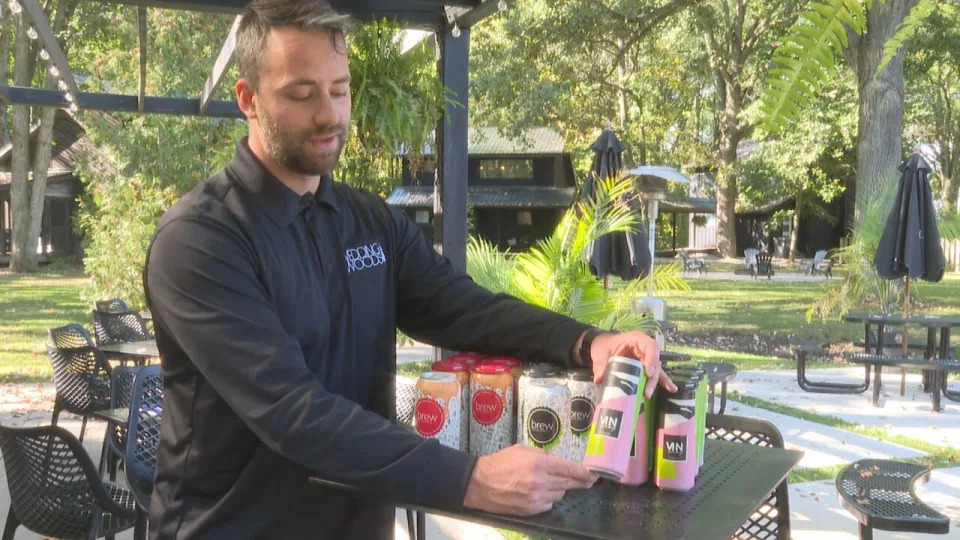
Jordan Goure of BREW Microbrewery and VIN Winery shows off the independent company's new Rosito canned sparkling wine beverage on their property in Essex on Oct. 6, 2023. (Dalson Chen/CBC)
Ciotoli said the change of plans was partly motivated by rising costs: He estimates the festival's expenses would have reached $80,000 this year.
But another factor in the decision was recognition of changing public tastes — reflected by lower ticket sales.
Ciotoli pointed out that the Windsor Craft Beer Festival isn't the only beer celebration that pulled the plug this year. There have been similar stories across North America.
Two craft beer festivals in Colorado — the Big Beers Festival in Breckenbridge and the WeldWerks Invitational in Greeley — didn't have 2023 editions.
The Washington Summer Brewers Festival, a tradition since the 1990s and considered the largest craft beer event in Washington state, was also cancelled.
Even the hipsters in Portland, Ore., have lost interest in craft beer: The Oregon Brewers Festival, one of the longest-running craft beer events in the United States, was among this year's cancellations.
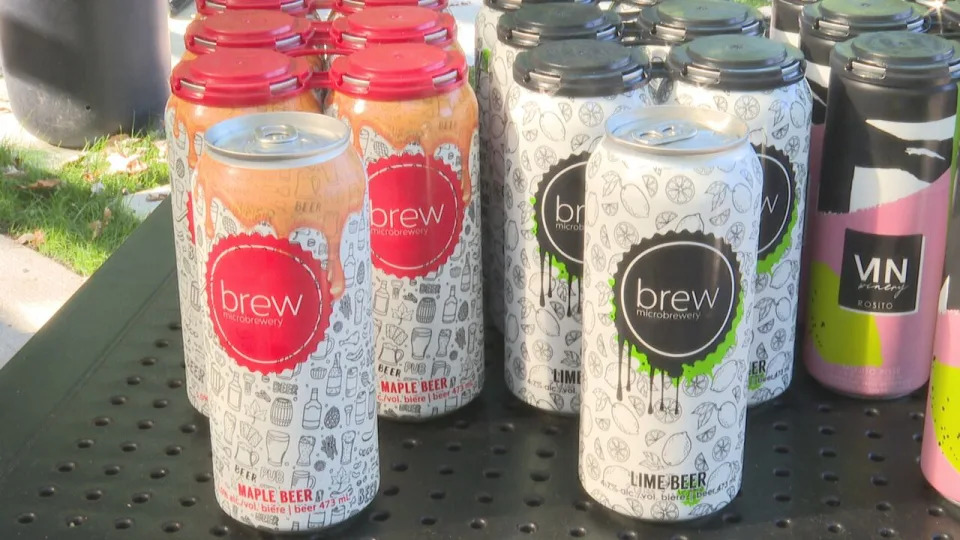
Products of BREW Microbrewery in Essex. (Dalson Chen/CBC)
"Beer festivals have really been going through a transformation," Ciotoli said. "You're seeing lower attendance across the board at multiple beer-focused festivals."
But if people aren't interested in craft beer anymore — what beverages are they excited about?
"We've seen a big shift toward non-alcohol cocktails, at least at our establishment," Ciotoli said. "We're definitely seeing an uptick in ciders."
Ciotoli said the Fall Beer & Cider Festival on Oct. 14 will have 10 vendors, and four of them will be cideries.

An illustration of beer mugs that's part of a promotional image for the Fall Beer & Cider Festival happening Oct. 14, organized by WindsorEats. (Dalson Chen/CBC)
WindsorEats aren't alone in changing to meet the preferences of the market.
BREW Microbrewery in Windsor-Essex has been a participant and vendor at the Windsor Craft Beer Festival since 2014.
This year's cancellation feels "a bit like the end of an era," BREW co-founder and co-owner Jordan Goure said. "it's a little sad, for sure."
But Goure is excited about his latest non-beer product: Rosito, a sparkling wine beverage in a can, offered through BREW's sister company, VIN Winery.
"The flavour is a little minty, a little sweet," Goure said. "We carbonate it and get it down to 5.5 per cent alcohol. It's more of a wine cooler.. We just launched it this summer. We plan on scaling this up and hopefully getting it into stores over the next few years."
Along with expanding to wine, Goure is pursuing other business interests such as hosting wedding events on the BREW property in Essex County.
"We get to see some of the LCBO stats and some of the internal numbers. Really, the sales trends have been down for craft beer," Goure said. "That's why, as a company, we decided to get into a growth beverage category, which is wine coolers and wine beverages."
Beer sales declining, stats show
Indeed, craft beer festivals being put on pause are only a symptom of a larger consumer trend.
Data from Statistics Canada released in February found that the volume of beer sold per person in Canada reached an "all-time low" from 2021 to 2022.
Total Canadian beer sales during that period dropped to about 2 million litres — the equivalent of 3.7 standard bottles of beer per week for every person in the country who is old enough to legally drink alcohol.
According to Statistics Canada, that's the lowest the figure has been since they began tracking alcohol sales in 1949.
In fact, Canadian beer sales have been trending downward since the 1970s.
Meanwhile, Canadian sales of ciders and wine coolers increased by 13.5 per cent from 2021 to 2022, and by 40.2 per cent from 2020 to 2021.
Despite such data, Ciotoli still believes there's always going to a segment of drinkers who are passionate about beer — especially craft beer.
"Craft beer is definitely still cool," he insisted. "If you love it, then it's cool to you."
Thursday, August 12, 2021
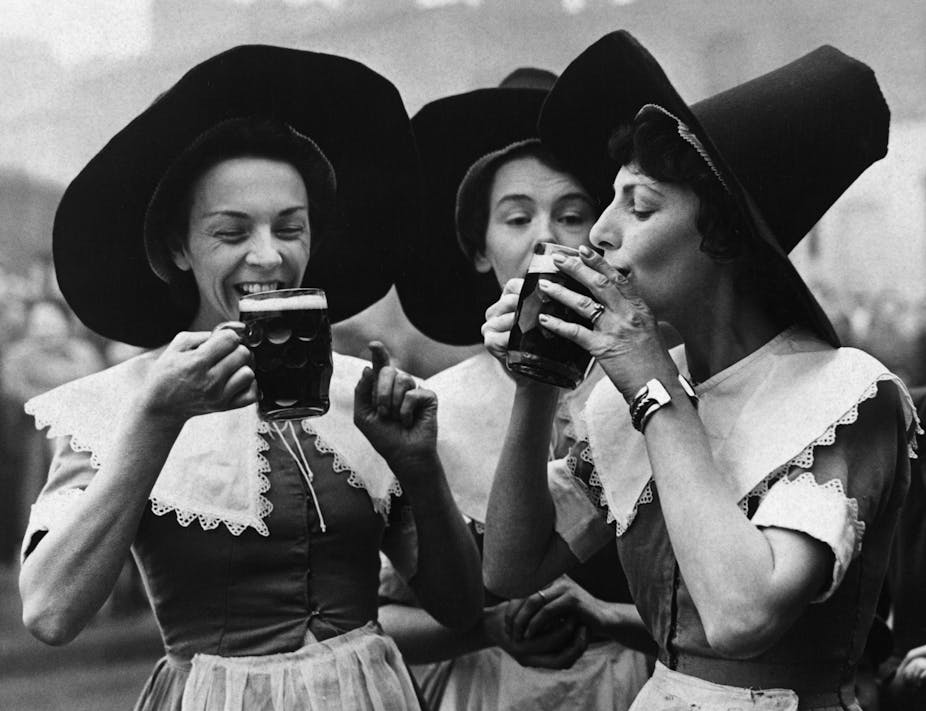
What do witches have to do with your favorite beer?
When I pose this question to students in my American literature and culture classes, I receive stunned silence or nervous laughs. The Sanderson sisters didn’t chug down bottles of Sam Adams in “Hocus Pocus.” But the history of beer points to a not-so-magical legacy of transatlantic slander and gender roles.
Up until the 1500s, brewing was primarily women’s work – that is, until a smear campaign accused women brewers of being witches. Much of the iconography we associate with witches today, from the pointy hat to the broom, may have emerged from their connection to female brewers.
A routine household task
Humans have been drinking beer for almost 7,000 years, and the original brewers were women. From the Vikings to the Egyptians, women brewed beer both for religious ceremonies and to make a practical, calorie-rich beverage for the home.
In fact, the nun Hildegard von Bingen, who lived in modern-day Germany, famously wrote about hops in the 12th century and added the ingredient to her beer recipe.
From the Stone Age to the 1700s, ale – and, later, beer – was a household staple for most families in England and other parts of Europe. The drink was an inexpensive way to consume and preserve grains. For the working class, beer provided an important source of nutrients, full of carbohydrates and proteins. Because the beverage was such a common part of the average person’s diet, fermenting was, for many women, one of their normal household tasks.
Some enterprising women took this household skill to the marketplace and began selling beer. Widows or unmarried women used their fermentation prowess to earn some extra money, while married women partnered with their husbands to run their beer business.
Exiling women from the industry
So if you traveled back in time to the Middle Ages or the Renaissance and went to a market in England, you’d probably see an oddly familiar sight: women wearing tall, pointy hats. In many instances, they’d be standing in front of big cauldrons.
But these women were no witches; they were brewers.
They wore the tall, pointy hats so that their customers could see them in the crowded marketplace. They transported their brew in cauldrons. And those who sold their beer out of stores had cats not as demon familiars, but to keep mice away from the grain. Some argue that iconography we associate with witches, from the pointy hat to the cauldron, originated from women working as master brewers.
Just as women were establishing their foothold in the beer markets of England, Ireland and the rest of Europe, the Reformation began. The religious movement, which originated in the early 16th century, preached stricter gender norms and condemned witchcraft.
Male brewers saw an opportunity. To reduce their competition in the beer trade, some accused female brewers of being witches and using their cauldrons to brew up magic potions instead of booze.
Unfortunately, the rumors took hold.
Over time, it became more dangerous for women to practice brewing and sell beer because they could be misidentified as witches. At the time, being accused of witchcraft wasn’t just a social faux pas; it could result in prosecution or a death sentence. Women accused of witchcraft were often ostracized in their communities, imprisoned or even killed.
Some men didn’t really believe that the women brewers were witches. However, many did believe that women shouldn’t be spending their time making beer. The process took time and dedication: hours to prepare the ale, sweep the floors clean and lift heavy bundles of rye and grain. If women couldn’t brew ale, they would have significantly more time at home to raise their children. In the 1500s some towns, such as Chester, England, actually made it illegal for most women to sell beer, worried that young alewives would grow up into old spinsters.
Men’s domination of the beer industry has endured: The top 10 beer companies in the world are headed by male CEOs and have mostly male board members.
Major beer companies have tended to portray beer as a drink for men. Some scholars have even gone as far as calling beer ads “manuals on masculinity.”
This gender bias seems to persist in smaller craft breweries as well. A study at Stanford University found that while 17% of craft beer breweries have one female CEO, only 4% of these businesses employ a female brewmaster – the expert supervisor who oversees the brewing process.
It doesn’t have to be this way. For much of history, it wasn’t.
Editor’s note: This article has been updated to acknowledge that it isn’t definitively known whether alewives inspired some of the popular iconography associated with witches today. It has also been updated to correct that it was during the Reformation that accusations of witchcraft became widespread.
Doctoral Student of English, University of Florida
University of Florida provides funding as a founding partner of The Conversation US.
Tuesday, August 30, 2022
Dr. Sylvain Charlebois - Yesterday

Total beer sales have actually dropped 7.3% compared to last year, according to a report obtained by Beer Canada.© Provided by Toronto Sun
When listening to reports about people going out and enjoying the weather, one can only assume that everything is back to normal. Not quite, especially for the beer industry in Canada. In fact, total beer sales have actually dropped 7.3% compared to last year, according to a report obtained by Beer Canada.
Total beer sales are up in Newfoundland and Labrador by a whopping 20.1%. But in other provinces, beer sales for both retail and service have dropped significantly. The largest drop so far this year has been in the province of Quebec. Beer sales have dropped 13.3% compared to last year. In Saskatchewan, sales have dropped by 12.6% and in Alberta, by 10.7%. All areas are in the red, except for the Territories. In the beer business, a simple -1% is massive, so the -3.3% in Ontario is considered a disaster. These drops are in addition to a disastrous 2021 when lockdowns were the norm to combat COVID. When things started to open earlier this year, this is not the scenario the beer industry was expecting — far from it.
In volume, beer sales are 8.3% below pre-pandemic levels. Beer sales have dropped for a variety of reasons. Firstly, our labour shortage is clearly a contributing factor. Restaurants are either closing earlier, or not opening some days during the week. Many locations are now opening only five days versus seven days as before. Many locations will close at 10 p.m. versus 12 a.m. or 2 a.m. Again, many operators cannot get the staff.
Public events are back, but we have had fewer of them across the country. And attendance in many cases have dropped significantly from pre-COVID standards. It will take a while before people get comfortable with our new post-COVID reality. We’re not sure what is in store for us this fall, pandemic-wise, but we are expecting people to behave with extreme caution, as they should.
As for consumers, they appear to be in a different place now. Home consumption beer sales this year so far have returned to pre-pandemic levels. But sales for beer consumed at restaurants and events remain 35% to 40% below pre-pandemic levels. Over the last three years or so, many of us were drawn instead to wine, spirits, and other products. Seltzer and ready-to-drink alternatives are also becoming more popular. In a nutshell, Canada went from being an on-premises beer drinking country to a more at-home wine and spirits drinking market. Many of us have tried new products and have experimented with new tastes and brands. These experiences have drawn many away from beer. Canadians are still drinking beer, but the numbers are telling us the percentage of beer drinkers has dropped significantly.
The other factor of course is inflation. Alcohol is obviously discretionary for consumers, and many are cutting back expenses these days to cope with skyrocketing food prices. Beer prices have also risen by 10% to 15% in the last 12 months, and will likely rise even more next year. In 2017, Ottawa introduced an indexation formula to raise taxes on beer, based on our consumer price index (CPI). With this year’s CPI, the deferral portion of taxes on beer could rise by up to 7% in April 2023, which is a record. Some provinces have expressed some sympathy by not raising their own tax portion on alcohol products, but not Ottawa. At least, not yet.
In essence, working from home changes our behaviours and food choices. The beer situation is one good example of how the food industry is being affected by a more home-based food market. People will drink beer at home, but going to events, and seeing friends at different locations will get people to consume more, but differently. Continuing labour issues and market changes will entice the food industry to adjust and seek new opportunities, for better or worse.
In the meantime, the year 2022 was to be a comeback year for the beer industry. Looks like it may need to wait a little longer for that to happen.
— Sylvain Charlebois is senior director of the Agri-Food Analytics Lab at Dalhousie University and a former member of the University of Regina faculty.
The boundaries of safe drinking have been redrawn.
Liz Braun - TORONTO SUN - TODAY

New study offers sobering info on alcohol and health risks© Provided by Toronto Sun
When it comes to drinking alcohol, is would seem less is better.
A report from the Canadian Centre on Substance Use and Addiction (CCSA) reveals that health risks skyrocket if you consume six or more alcoholic drinks a week — and those risks include seven types of cancer as well as heart disease and cirrhosis.
Two drinks a week (or fewer) is a low-risk undertaking.
Between three and six carries moderate risk; risk level is high, “for those who consume above six standard drinks per week, with increasingly higher levels of risk with every additional drink,” according to the report.
The risks of health harms for women increase more steeply than for men once you go above low levels (two drinks a week) of consumption.
The report states that women experience more risk of damage or disease, “such as liver disease, at lower levels of alcohol consumption than do males.
“In general, males are more likely to develop alcohol use disorders, but females are more likely to develop organ and other bodily damage from drinking alcohol,” the report says.
The new guidelines, based on global research, are aimed at heightened awareness.
Many people are apparently unaware of just how dangerous alcohol is to health.
The fact that alcohol is a known carcinogen and causes breast, colon, mouth, rectum and a few other hideous cancers is apparently not a well-known fact in Canada.
Drinking contributes to heart disease and stroke. Past reports that it might protect against heart disease no longer stand up — drinking more than a little is a risk factor for heart attack, stroke, high blood pressure and coronary artery disease.
And alcohol is implicated in dementia, sexually transmitted diseases and a whole host of other negative outcomes.
The study reports, “Disproportionately more injuries, violence and deaths result from men’s drinking,” which opens a whole subset of other health problems such as drunk driving, intimate partner violence, sexual violence and all manner of alcohol-fuelled aggressive behaviour.
The last time alcohol guidelines were laid out was 2011 and newer research made it clear it was time to issue those guidelines again.
Researchers say alcohol should carry the same information and health warnings that food labels provide.
“A direct consequence of the current project is a recommendation for Health Canada to require, through regulation, the mandatory labelling of all alcoholic beverages to list the number of standard drinks in a container, the Guidance on Alcohol and Health, health warnings and nutrition information,” the report says.
Researchers state that a cultural shift around drinking is required: “it is necessary to promote the message that it is okay not to drink alcohol.”
So, perhaps no more buck-a-beer type slogans, folks.
On the upside, any reduction in drinking alcohol is beneficial. Cutting back can start to reverse the damage from alcohol-related chronic disease.
Tuesday, July 12, 2022
North Korea is raising a glass to celebrate the 20th anniversary of the pouring of the first pint of its flagship Taedonggang beer — although the accolades have failed to acknowledge its distinctly capitalist roots.

North Koreans are proud of their national beer without knowing about its foreign heritage
With a "crisp and clean finish," the beer is extremely popular in the beer gardens of Pyongyang in the summer months — even though drinkers have no idea that its distinctive flavor is a legacy of its foreign heritage.
The state-run Korean Central News Agency published a story recently in which it feted the brewery's two decades of creating beer in Pyongyang, emphasizing that the factory was "built under the care of Chairman Kim Jong Il," the leader of the nation when construction commenced in 2000.
Apparently, the portly dictator "initiated the construction of the new factory producing beer of the best quality for the people." He also selected the site for the factory, KCNA reported, and "showed deep care for its construction."
'Flavor and quality'
Kim Jong Il's son and heir, Kim Jong Un, has followed the brewery's progress, visiting the site several times to "encourage its officials and workers to further improve the flavor and quality of beer and thus exalt the honor of the factory as the one popular among the people," according to state media.
The brewery produces 70,000 kiloliters of beer a year, utilizing water from the natural springs in the Milim district and barley and hops grown in the North. The factory's beer has an alcohol content of 5.7%, which is unusually high for a beer produced in East Asia but also an indication of its heritage.
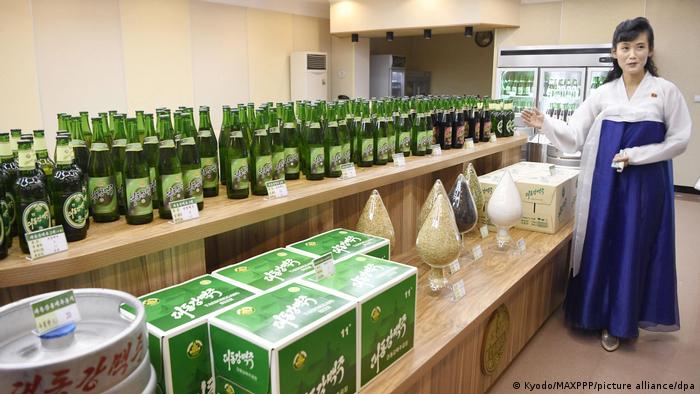
North Korea's Taedonggang beer has a taste closer to an English ale
In 2000, relations between North Korea and the rest of the world were in a far more positive state and, relatively well financed at the time, the government in Pyongyang decided it wanted a brewery. With virtually no domestic knowhow, it decided the simplest way of achieving that aim would be to purchase a foreign beer-making facility.
Through connections in Germany, North Korea asked business broker Uwe Oehms to secure a suitable brewery. After scouring Europe for a suitable plant, Oehms discovered that a plant that had been operated by British brewers Ushers in the town of Trowbridge, in Wiltshire, had recently been closed down and the equipment was being sold off.
"It all came as a bit of a surprise when we heard that it was being sold to North Korea," said Gary Todd, who had been the head brewer until the plant was closed down and was asked to assist in the sale.
"One day, these North Korean government officials and some brewers arrived, although it was very clear that they know nothing about brewing," Todd told DW. "There were also some Russian engineers involved and, because of all the languages, it was a very complicated process."
Teaching brewing skills
It was quickly apparent that Todd would need to walk the inexperienced North Korean brewers through every step in the process required to turn the raw materials into beer. That crash-course in brewing took five months, during which the brewery and all its fixtures and fittings were being taken down around them, carefully packaged up and prepared for shipping to North Korea.
"They were very impressed with the Ushers set-up and seemed excited that they were going to be able to move it all to North Korea and set it all up again," he said. "But they wanted absolutely everything in the building. They wanted all the plastic cups from the drinks vending machines because they said they couldn't get them back home.
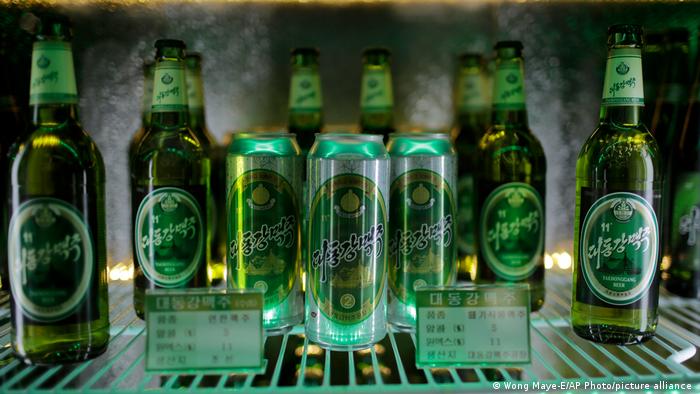
Sanctions on North Korea now mean that it is virtually impossible to purchase Taedonggang beer outside the country
"They wanted the toilet seats — I remember one walking around with a toilet seat around his neck — and the bolts in the floor," he added. "They took the tiles off the wall one-by-one and took them all away."
Towards the end of the project, the North Koreans caught Todd by surprise.
"They told management that they wanted me to go to North Korea to set everything up and start the brewing processes, but it would have been a two-year commitment, at least, and I had a young family at the time and I didn't want to go."
Still, he did get to enjoy a bottle of Taedonggang beer some years later when a journalist who had visited the plant in Pyongyang brought him a souvenir of the trip.
"It was very good — far better than I had expected — and I was impressed," he said. "It was crisp and with a good clean finish."
North Koreans are also proud of their national beer.
"I remember being surprised at how 'deep' the taste was, at least in comparison to Japanese beers," said Chung Hyon Suk, a North Korean resident of Japan who has made regular trips back to her homeland in the past.
Riverside beer gardens
"There were a lot of beer gardens alongside the Taedonggang River in central Pyongyang and people would go there after work in the summer months to relax and meet their friends," she told DW. "My friends told me that it was their favorite thing to do when it was hot and it was really popular with younger people and women."
Sadly, she said, international sanctions on North Korea now mean that it is virtually impossible to purchase Taedonggang beer outside the country, while the closure of the border with China due to the coronavirus pandemic has made it even harder to find the beer abroad.
"I remember it being darker in color than Japanese beer and with a taste that was closer to an English ale," she said.

NORTH KOREA IN PICTURES: A RARE GLIMPSE INTO THE ISOLATED COUNTRY
On the road
The reporters from AP covered over 2,150 kilometers (1,336 miles), in a country of barely 25,000 kilometers of roads, merely 724 of those paved. They came back with only their photos as evidence of the life in the northern part of the secluded country. In the picture: A woman walks along a road southeast of Pyongyang in North Korea's North Hwanghae province.
12345678910111213
Edited by: Shamil Shams
Thursday, November 23, 2023
CBC
Wed, November 22, 2023
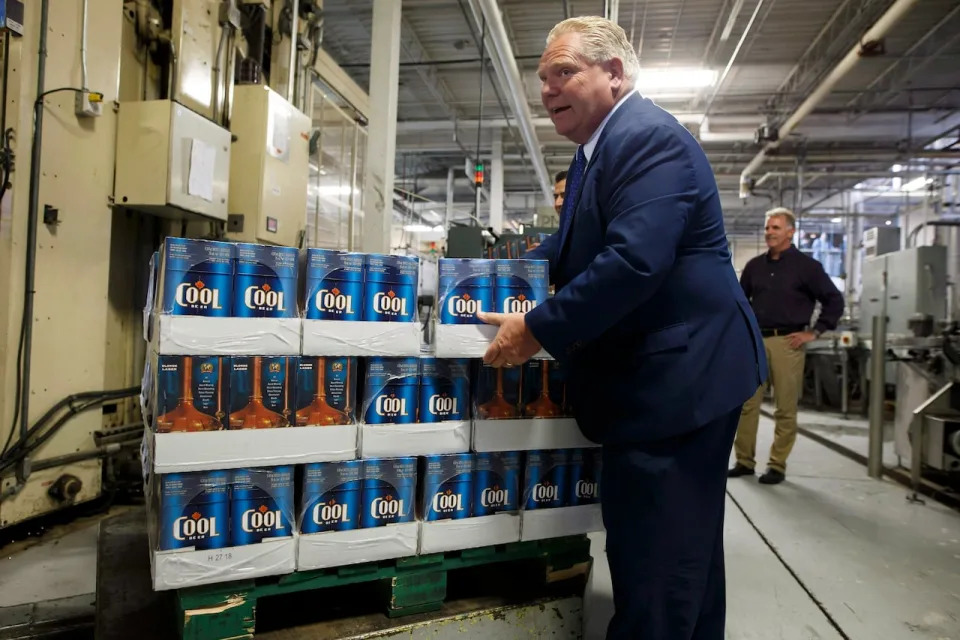
During the 2018 election campaign, PC leader Doug Ford promised to allow Ontario convenience stores to sell beer and wine. He has been unable to make that happen since becoming premier, in large part because of a contractual agreement between the province and the Beer Store that runs until the end of 2025.
Premier Doug Ford's government is preparing to change the rules on how beer, wine, cider and spirits are sold in Ontario, and there's plenty at stake — well beyond whether you'll be able to pick up a case at the corner store.
Industry officials expect the government's moves will affect how all types of alcohol are retailed.
The looming reforms also pit a range of interests against each other, as big supermarket companies, convenience store chains, the giant beer and wine producers, craft brewers and small wineries all vie for the best deal possible when Ontario's almost $10-billion-a-year retail landscape shifts.
As the negotiations proceed, the Ford government faces its own internal dilemma between its competing desires of giving the free market more control of booze sales vs. keeping LCBO revenues flowing into the provincial treasury.
The government has for months been engaged in closed-door consultations with industry players on what it calls "modernizing" the alcohol sales regime in Ontario.
For Ford's Progressive Conservatives, the chief goal is meeting a yet-to-be-fulfilled 2018 campaign promise to allow convenience stores to sell beer and wine. But multiple sources in various parts of the alcohol and retail industry say much more than that is on the table.

The LCBO turned a profit of nearly $2.5 billion in the 2022-23 fiscal year, off $7.4 billion in gross revenue. (David Donnelly/CBC)
CBC News did lengthy interviews with eight people from across the beer, wine, spirits and retail sectors. All of them agreed to speak only on condition of anonymity, because the government required everyone involved in the consultations to sign non-disclosure agreements.
Here's what they say are the issues at stake:
Will the government shrink the LCBO's profit margins, including its take from products that other retailers sell?
Will retailers such as grocery and convenience stores be required to devote a certain amount of shelf space to Ontario-made beer and wine, or will they have total control over the inventory they stock?
Will small Ontario vineyards get any help in competing against big Ontario wineries whose products can contain as much as 75 per cent imported wine?
How big of a presence will the Beer Store maintain, and will it remain the only place Ontarians can bring back their empties for a deposit refund?
Will craft breweries be allowed to open more retail outlets, and will they get the tax cuts they're seeking?
Will spirits be part of the retail reform, including the sale of ready-to-drink products such as vodka coolers or hard seltzers in grocery and convenience stores?
Profit margins, markups, taxes
At its most fundamental level, much of the negotiations boils down to who gets the opportunity to make money off the various points of the alcohol supply chain, and how much.
"It's a lot of money at stake," said a source in the wine industry. "We're talking billions."
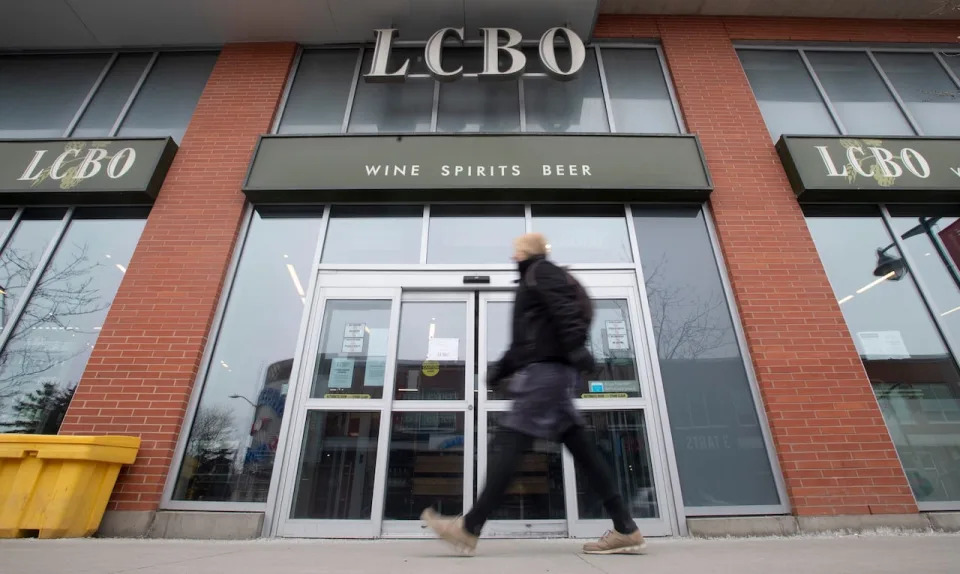
A person walks past an LCBO in Ottawa, Thursday March 19, 2020.
The LCBO operates 669 retail stores across Ontario. (Adrian Wyld/The Canadian Press)
From $7.4 billion in sales in the 2022-23 fiscal year, the LCBO turned a profit of nearly $2.5 billion. Retailers, wineries and breweries are all hoping for a piece of that.
On a typical bottle of Ontario wine for instance, the producer currently gets roughly 30 to 45 per cent of the sticker price, according to industry officials.
The LCBO's own price calculators show it puts a 114 per cent retail markup on Ontario wine. One example shows wine supplied by a producer at $8.33 per bottle retailing for $22.30, once the markup, government levies and HST are added in.
Wine producers say the LCBO could afford to give a little on that markup, or the government could allow winemakers more opportunities to sell from their own retail outlets, so they get to keep the markup.
Craft brewers' biggest pricing concern is the impact of taxes. They say Ontario has the highest tax on craft beer of any province, a rate that is eight times higher than what's in effect in Quebec.
They also want the government to scrap the 9 cent environmental fee the province levies on each can of beer, which is different from the 10 cent deposit that consumers pay on a can.
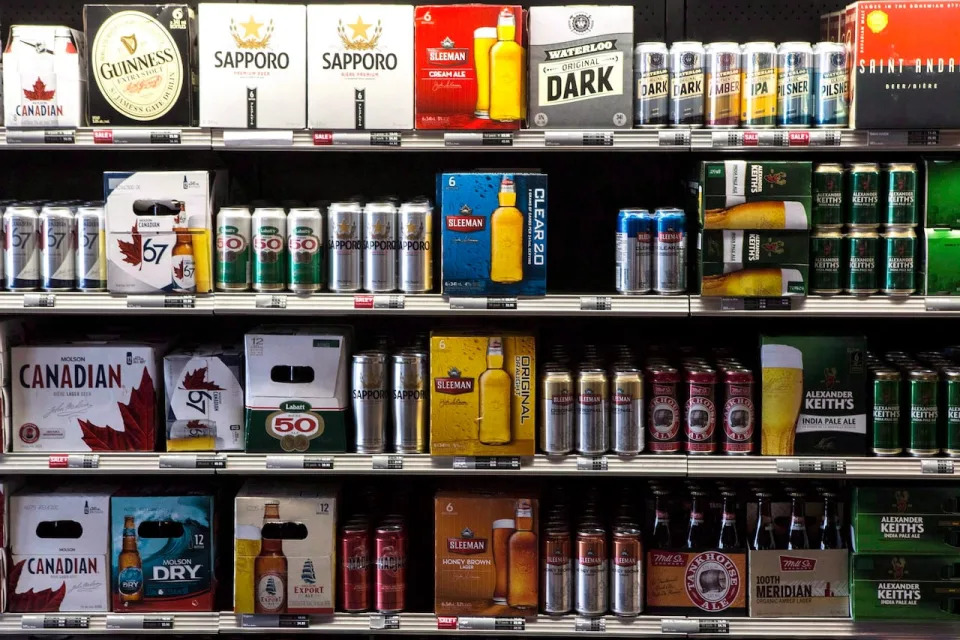
Beer products are on display at a Beer Store outlet in Toronto.
Big brewery companies and small craft brewers want the Ontario government to reduce the province's beer taxes. (Chris Young/The Canadian Press)
Terminating Beer Store agreement
All sources expect the government to give notice by the end of December that it intends to terminate the contract that sets out the rules for beer sales in the province, known as the Master Framework Agreement (MFA), as also reported by The Toronto Star.
The latest version of the agreement, signed in 2015 between the then-Liberal government and the Beer Store, opened the door to beer and wine in Ontario supermarkets.
But it limits the number of grocery locations to 450, precludes them from selling anything larger than a six pack, and bars convenience stores from selling beer (although 7-Eleven has been approved for liquor licences for on-site consumption with food at nearly all of its Ontario stores).
The agreement will remain in effect until the end of 2025, so the termination notice "is just the starting gun" for a two-year transition to a more wide open retail market, says a source in the craft beer industry.
While sources are certain the government will terminate the agreement, they're uncertain about what will replace it.
"The MFA has never been about choice, convenience or prices for customers, it has always been about serving the interests of the big brewing conglomerates, and that's what needs to be addressed," said Michelle Wasylyshen, spokesperson for the Retail Council of Canada, whose board of directors includes members from Loblaw, Sobeys, Metro, Walmart and Costco.
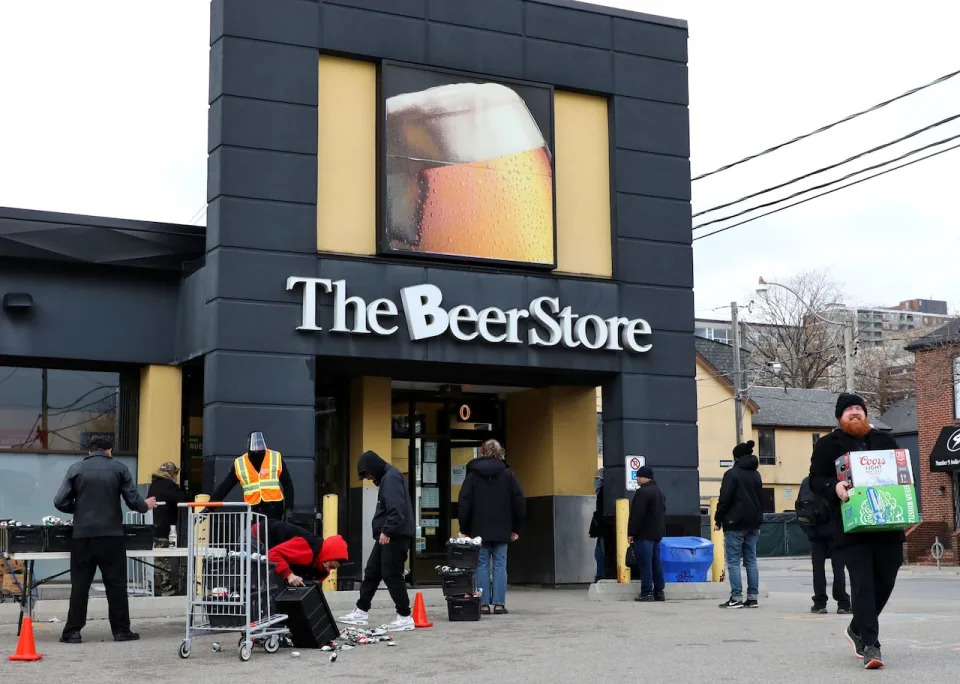
People line up in a parking lot for a long wait to return empties or buy beer at a Beer Store in downtown Toronto on April 16, 2020.
Industry sources expect the government will give notice by the end of December that it intends to terminate the Master Framework Agreement between the province and the Beer Store. The current version of the agreement, signed in 2015, allows 450 supermarkets in the province to sell beer but precludes them from selling any formats larger than a six pack. (Colin Perkel/The Canadian Press)
More retail outlets
While Ontario's current regulations limit who can sell alcohol as a retailer, and in what formats, the limits on the biggest players in the industry are far less strict than what small breweries and wineries face.
Wine Rack has 164 locations. It is part of Arterra Wines Canada, the company that owns such wineries as Jackson-Triggs, Inniskillin and Sandbanks.
The Wine Shop (100 locations) is part of Andrew Peller Ltd., the company that owns such wineries as Peller Estates, Trius and Wayne Gretzky Estates.
By contrast, each craft brewery can only have two retail outlets, and both must be attached to a production facility. Each small winery can only have one retail outlet, located where it grows grapes and makes wine.
Both the craft beer and small winery sectors want those restrictions scrapped.
"If anybody thinks the government is politically hurt by picking fights with large corporations, they're very wrong," said a source in the wine industry.
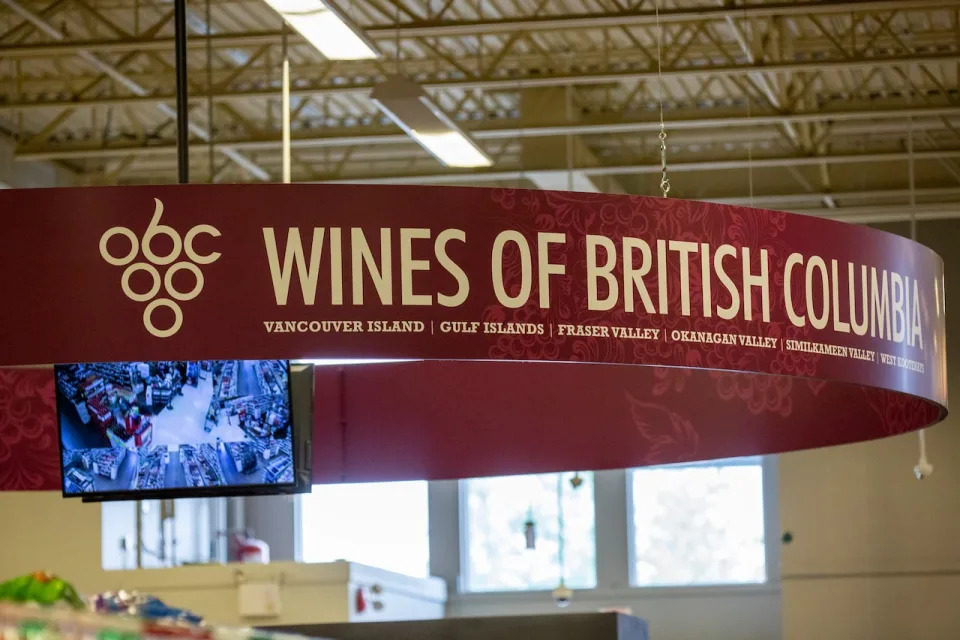
A sign over the wine aisle at Save-On-Foods grocery store in Richmond, British Columbia pictured on Thursday July 11, 2019.
Ontario wineries are looking to supermarkets to do more to promote local wineries, like this grocery store does in Richmond, B.C. (Ben Nelms/CBC)
Rules for supermarkets
Those same regulations governing retail outlets also set down the rules for the 450 grocery store locations that are permitted to sell beer, wine or cider.
Sources say the big supermarket chains are pushing the government to lift some of the restrictions that dictate how they can and can't sell products.
"I think the biggest concern is, what is 'big grocery' going to get at the table?" said another wine industry source. "The industry just wants to make sure there are programs and supports in place if they're going to compete in an open market."
Under the current rules, supermarkets must ensure that at least 20 per cent of beer and cider on display and 10 per cent of wine comes from small producers. Local producers would like to see assurances of more shelf space devoted to "made in Ontario" products.
The rules also prohibit supermarkets from charging brewers and wineries any listing or stocking fees to put their products on the shelves (as is the practice with many ordinary grocery items). Craft brewers and small wineries want that ban kept in place.
The current rules ban the supermarket chains from selling any brands of beer or wine in which they have "direct or indirect financial interest."
That stops Costco, for instance, from selling its own private-label Kirkland Signature wine in Ontario, and would prevent other supermarket chains from launching their own beer or wine products. Industry insiders are wondering if the government will scrap that rule.
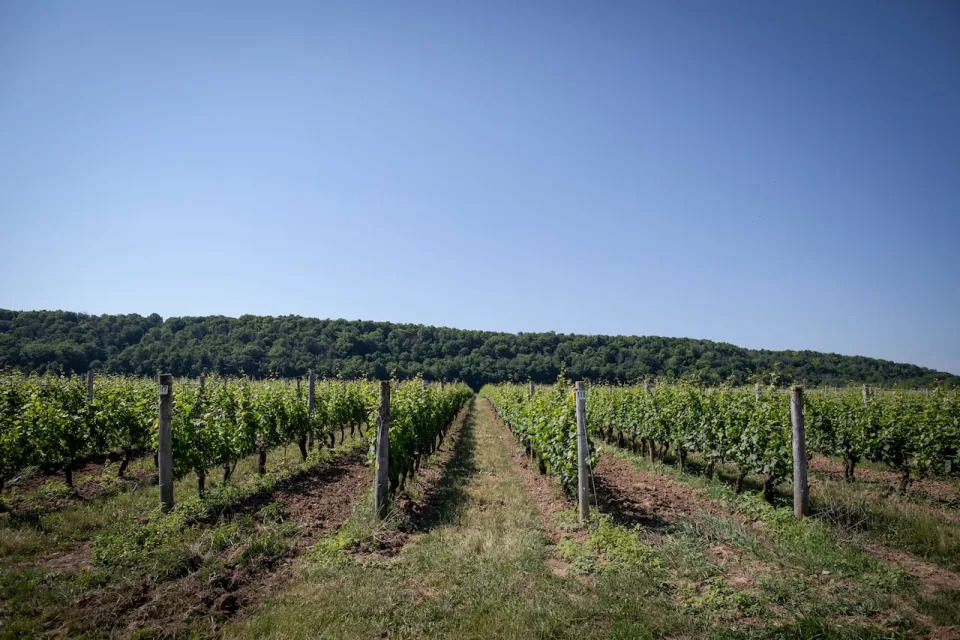
Malivoire winery, in Beamsville, Ont., on June 29, 2020.
Under Ontario's current rules, at least 10 per cent of the wine on display in supermarkets must be produced by small wineries. (Evan Mitsui/CBC)
Big wine versus small wine
If the new retail landscape allows the supermarket chains free rein over their inventory, Ontario wineries are worried they'll get pushed off the store shelves by imports.
"Retail expansion must be done right or else it threatens the future of Ontario wine and further supports heavily subsidized, foreign wineries," said a joint report issued in May by Wine Growers Ontario (big producers) and Ontario Craft Wineries (small producers).
Those two groups don't always see eye to eye on the issues, in part because a significant portion of the wine sold by Ontario's biggest wine producers isn't actually made in Ontario. These "international domestic blends" contain up to 75 per cent imported wine and are sold under the label of some of Ontario's best known vineyards.
"The market is dominated by big companies," says a source who runs a small winery. "It's David and Goliath."
The source says it's challenging for small wineries to have much presence in LCBO locations, which means the major brands become the biggest sellers, and in turn grocery stores are reluctant to stock wines that don't already have big brand recognition.
"This should be a political no-brainer to be on our side," said the source. "We've got to hope the premier sees it that way, that we are the little guys and he has the opportunity to help a domestic industry."
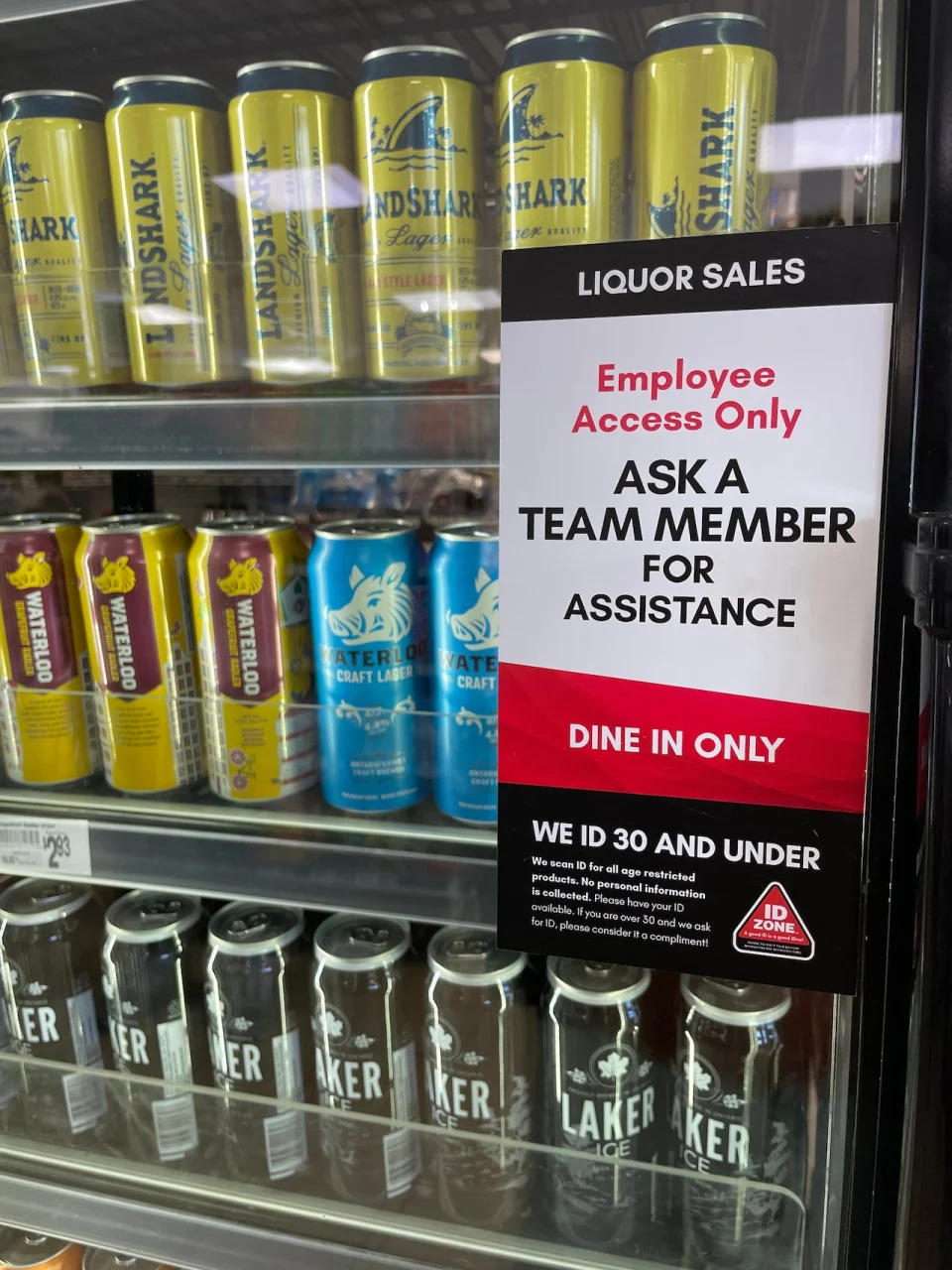
7-Eleven has been approved for licences to serve alcohol for on-site consumption at nearly all of its stores in Ontario. So far, licences have actually been issued and sales commenced at only two of the convenience store chain's locations, in Leamington and Niagara Falls, pictured here.
7-Eleven has been approved for licences to serve alcohol for on-site consumption at nearly all of its stores in Ontario. As of July 2023, sales had commenced at only two of the convenience store chain's locations, in Leamington and Niagara Falls. (Pelin Sidki/CBC)
Convenience stores
When Ford made his campaign promise to allow corner stores to sell beer and wine, he ignored the fact that doing so would have put the province on the hook to the big brewers for hundreds of millions of dollars, under the terms of the Master Framework Agreement.
That's why the government backed away from the plan, and waited until that contract with the Beer Store got closer to its expiration date. The timing actually works out to be politically convenient for Ford's PCs: it sets the stage for beer and wine in the corner stores in early 2026, just before the next election, scheduled for June that year.
Convenience stores are confident the government will make good on the promise, but they have some concerns about the price structure they will face.
"Margins are going to be the biggest factor," says a convenience store industry source. "The LCBO is the biggest barrier right now. The LCBO handling fee is just so high."
In Quebec, where stores negotiate directly with brewers, the source says the profit margin on beer in convenience stores averages 18 per cent, far more than what Ontario grocery stores currently take in.
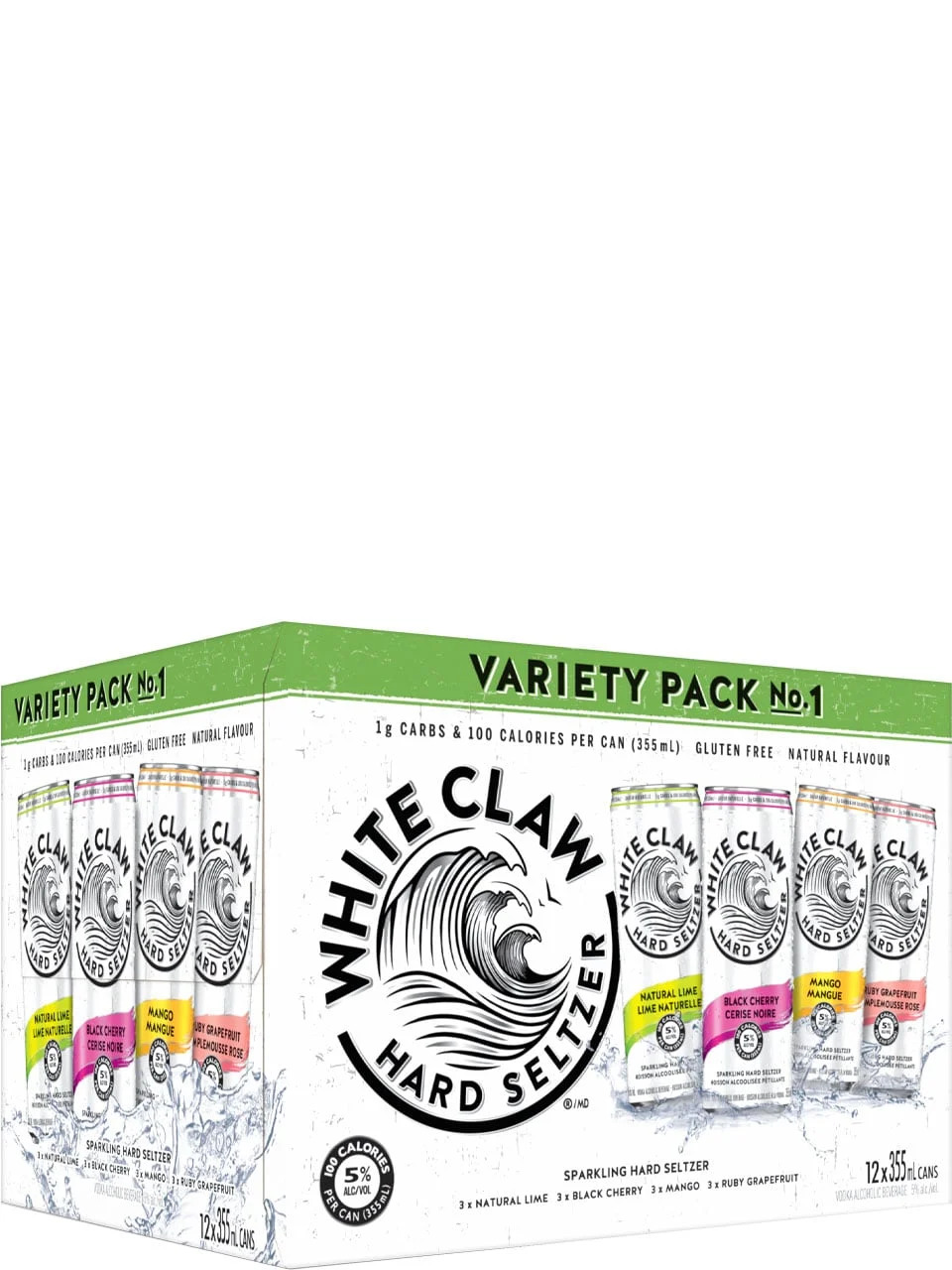
The companies that produce pre-mixed alcoholic beverages, such as coolers and hard seltzers, want their products to be available for purchase in Ontario grocery and convenience stores. (Newfoundland Labrador Liquor Corp.)
Spirits and ready-to-drink beverages
Much of the debate in Ontario about liquor retailing centres on how beer and wine are sold, often leaving spirits out of the equation.
While distillers aren't necessarily looking to sell bottles of vodka, whisky and rum from convenience stores, they are seeking more equitable treatment as the province reforms its alcohol retail laws.
"It's a big job, 100 years of Prohibition-era regulations that need to be untangled," says a source in the spirits industry.
Distillers are seeing growth in the sales of pre-mixed alcoholic beverages, such as hard seltzers and coolers. Their position is that these ready-to-drink items are similar to beer and cider in size, packaging and alcohol content, so should be treated no differently at the retail level.
Right now, the only retailer where you can buy these products is the LCBO. The industry wants them made available in grocery and convenience stores.
"In a place where you can buy beer, wine and cannabis in privately run stores, it's kind of weird that you can only buy spirits in a government-run store," said the source.
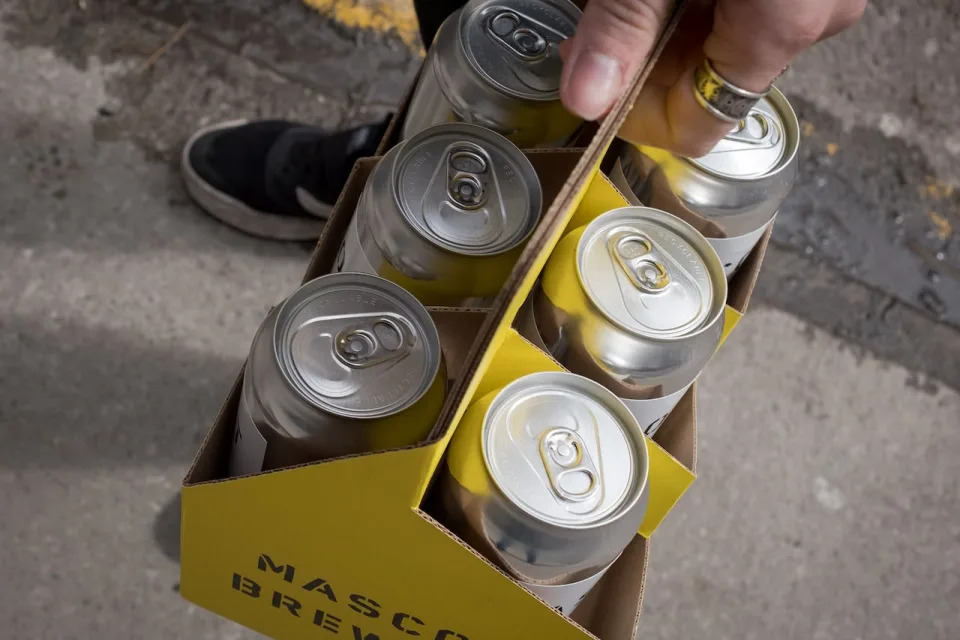
The alcohol retail market in Ontario totalled $9.8 billion in 2021-22, according to Statistics Canada. (Evan Mitsui/CBC)
Wholesaling and distribution
While the average consumer is aware that the producer and the retailer of booze get a share of the sticker price, there's also money to be made in wholesaling and distribution.
The LCBO and the Beer Store have a stranglehold on distribution right now. Both the supermarket chains and the convenience store industry want that loosened.
"Preventing a monopoly on distribution is in the best interest of Ontarians and convenience retailers across the province," says the Convenience Industry Council of Canada in a statement.
"All of the major wholesale distributors in Ontario should be allowed to distribute alcohol from manufacturers to convenience store locations."
A source with one of the major breweries counters that the Beer Store has distribution down to a fine art.
"It's really difficult to see how any other entity would do it and not increase the price of beer," said the source.
Saturday, June 09, 2007
Bush Beer
Having not had a beer in a long time, and forgetting that real beer, that is any beer other than American brands, actually has head and foams, George pours himself a glass and it overflows all over the table and onto his lap much to his surprise. The following day he absented himself in the AM with the traditional morning sickness of a heavy night of carousing.
REFORMED boozer George W Bush knocks back a large glass of lager at the G8 summit - sparking fears that he has fallen off the wagon.
Now-teetotal Dubya, who admitted during his first presidential campaign that he used to drink far too much, downed the beer while taking a break with Tony Blair, German president Angela Merkel and the Italian prime minister Romano Prodi.
And he seemed to be getting quite jolly during their get together - throwing back his head and roaring with laughter during their chat.
White House staff say they're not sure whether it's something he ate or a stomach virus.
As to suspicions that the was doing a "Boris Yeltsin" - US officials insist that was a non alcoholic beer he was seen drinking last night.
I wonder if he was drinking a Bush Beer?
Of course being amongst his equals, it is easier to converse and imbibe in mutual conviviality than if one has to actually meet the common folks, the salt of the earth, the American voter.
Bush
Brewery: Dubuisson
Category: An amber beer/barley wine
Taste: perfume like flavour with a strong whisky like after glow..
Strength: 12.0%.
Serve: cooled
My first encounter with this beer was at the beautiful Ciro bar in the centre of Brussels, I was discussing the merits of Belgium beer with a local and explained how I disliked the strong tasting trappist beers. The local said he understood so he would order something special for me, along came a beer called Bush! Beware this little beer is a wolf in sheeps clothing, it may taste only mildly alcoholic but it packs the punch of a sledgehammer.
Long-Awaited Beer With Bush Really Awkward, Voter Reports
Although respondents to a Pew poll taken prior to the 2004 presidential election characterized Bush as "the candidate they'd most like to sit down and have a beer with," Chris Reinard lived the hypothetical scenario Sunday afternoon, and characterized it as "really uncomfortable and awkward."
Reinard, a father of four who supported Bush in the 2000 and 2004 elections, said sharing a beer with the president at the Switchyard Tap gave him "an uneasy feeling."
"I thought he'd be great," Reinard said. "But when I actually met him, I felt real put off."
Find blog posts, photos, events and more off-site about:
George W Bush, Bush, President, beer, G8,
US
Sunday, March 01, 2020
CORONA BEER NOT VIRUS
A survey says 38% of drinkers won't touch Corona because of epidemic fear. Corona says despite that 'misinformation,' sales are strong.
Áine Cain
The marketing-research firm YouGov estimates that Corona Extra beer's image has taken a hit thanks to the coronavirus.
For its part, the beer brand's parent company disputes the idea that the epidemic is a major drain.
"Sales of Corona remain strong, and we appreciate the continued support of Corona drinkers," a spokesperson for Constellation Brands told Business Insider.
There is no link between the coronavirus and the beer brand.
Corona — Latin for "crown" — is one of the most popular beer brands, and its labels are aptly adorned with a golden crown.
But the link between the word "corona" and a global epidemic has led to questions about whether or not Corona is in for a branding nightmare. The coronavirus, which causes the disease COVID-19, has killed at least 2,900 people around the world since it originated in China in December. Its name was derived from the crown shape its viral particles form.
Constellation Brands, which has the exclusive license to distribute Corona Extra in the US, has unequivocally said that concerns that shoppers are ditching the beer because of fears over the illness are misleading.
"There's a good amount of misinformation out there that doesn't match the reality of the business or consumer sentiment," a Constellation spokesperson told Business Insider. "Sales of Corona remain strong, and we appreciate the continued support of Corona drinkers."
The market-research firm YouGov calculates "buzz" scores for brands based on an average daily sample size of 357 respondents with an opinion on a brand. The firm also breaks down "purchase intent" for different products and brands based on an average daily sample size of 2,110 participants.
YouGov found that Corona beer's buzz score dropped from 75 at the start of 2020, around when news of the coronavirus first began to spread, to around 51 in February. YouGov said the beer brand's additional drop regarding "purchase intent" could also be attributed to it being "closely associated with beach holidays."
And in a case of unfortunate timing, Corona just released a hard-seltzer campaign based on the slogan "coming ashore soon" — which, given the spread of the coronavirus from China to 55 countries around the globe, landed with a thud on social media.
But for its part, Constellation Brands has maintained that it trusts consumers not to link the epidemic to its beer brand.
"We believe, by and large, that consumers understand there's no linkage between the virus and our business," Maggie Bowman, a representative for Constellation Brands, told Business Insider in January.
Corona beer maker says U.S. sales remain strong despite virus outbreak
(Reuters) - Corona beer maker Constellation Brands Inc (STZ.N) said on Friday sales of its Corona Extra beer remained strong in the United States in the four weeks to Feb. 16, amid the rapid global spread of the coronavirus.
The Modelo Especial beer maker also said all units supporting its beer business are seeing positive sales trends for the brand thus far in 2020 despite claims about the impact of the coronavirus on its business.
There have been a few media reports inaccurately claiming sales of the beer were being impacted by the virus, a Constellation spokesman said.
“We’ve seen no impact to our people, facilities or operations and our business continues to perform very well,” Chief Executive Officer Bill Newlands said in a statement.
Newlands added the company does not have much exposure to international markets such as China that have been most impacted by the outbreak.
The epidemic has killed over 2,700 and infected at least 80,000 people, most of them in China.
Reporting by Praveen Paramasivam in Bengaluru; Editing by Shailesh Kuber
Thursday, April 15, 2021
Remains of a 5,000-year-old brewery have been uncovered in Egypt. So, how did beer make its way from the land of the Pharaohs to Germany?

Remains of vats used for beer fermentation were uncovered
Archaeologists from the USA and Egypt have unearthed an ancient brewery on the banks of the Nile. Cairo's tourism ministry says the site, which dates back 5,000 years, would once have been capable of producing 22,400 liters of beer per batch.
In antiquity, the fermented barley juice served as a drink for almost the entire population and was regarded as a staple food. The beer was made from a mixture of water and barley that was heated and then fermented. That mixture was partly seasoned with fruit juice concentrates, filtered and served as a thick, sweet drink.
This find and others in the last 12 months have created hope for new breath of life into Egypt's mummified tourism sector. In 2010, some 14.7 million tourists came to Egypt. Those figures collapsed in 2011 during and after the Arab Spring; and took another blow from Egypt's military coup in 2016. The industry slowly regrew for the next few years, only to be flattened again by the coronavirus pandemic. In 2019, the country had 13.1 million tourists; that had shriveled to just 3.5 million in 2020.
The discovery of what the Egyptian tourism ministry is calling "the oldest high-production brewery in the world," at Abydos, near Luxor, could help build a thirst for Egyptian tourism again.
As the discovery of the "snack bar" in Pompeii in 2020 proved, culinary finds are very popular with the public. Archaeologist and director of the Burg Linn Museum, Dr. Jennifer Morscheiser agrees: "As an archaeologist you know what the press loves: All finds that have to do with sex, alcohol or seasonal holidays."
ANCIENT TREASURES FOUND IN 2020
Saqqara
Saqqara, the necropolis of the city of Memphis, about 30 kilometers south of Cairo, is considered one of most important archaeological sites in Egypt together with the Valley of the Kings and the pyramids of Giza. The settlement struck the headlines this year with yet another spectacular discovery: In September and October, researchers found beautifully decorated wooden coffins. PHOTOS 123456789
Cooler climate, falling wine production — a beer storm was brewing
In 2011, Morschheiser herself stumbled over the remains of an ancient brewery — in Bonn on the banks of the Rhine — built by the Romans 2,000 years ago.
"It is a credible idea that there was a move to make drinks more preservable and relatively germ-free, especially 2,000 or 5,000 years ago, when wells, sewage systems and rivers were only partially separated from one another," explains Morscheiser.
That might explain why beer brewing became popular thousands of years ago. But how did beer brewing come to be in the area where Germany is today, in Northern and Central Europe?
There are several possible pathways. The Greeks are thought to have learned to brew beer from the Egyptians during the third century BCE, but it's unclear whether the Romans learned from Greeks or from the Egyptians after the Roman conquest in North Africa, in 32 BCE.

The Abydos archaeological site is seen as the oldest high-production beer brewery uncovered to date
In Central Europe, there is evidence that the Celts were fermenting grain to make alcohol around the same time; and it's entirely possible that other European peoples discovered the fermentation process independently.
"Beer and mead were already known to the Celts, but the hype and mass production didn't begin until the middle of the second century AD," explains Morscheiser.
'The aqueducts were left to decay, but not the brewing'
Although the Romans may have regarded it as a second class drink, the Teutonic love for beer has remained ever since.
"As far as I can see, brewing has continued since then," says Morscheiser.
"It even survived the fall of the Roman Empire — the aqueducts were left to decay, but they didn't want to give up brewing beer."
But beer in Europe was still being fermented on a small scale; and that's the way it would stay until the Middle Ages, when Christian monasteries started to brew larger quantities. It was only with the industrial revolution that Europe began brewing on an industrial scale.
Nowadays, beer is a big tourist drawcard for Germany. That point is abundantly clear every September when around six million tourists usually visit Oktoberfest in Munich.
But the brewery which was recently uncovered by archaeologists in Egypt may have been about making beer for a less cheerful occasion. The head of the excavation, Matthew Adams of New York University, believes it's possible that the brewery's purpose was to provide drinks for the funeral rites of the pharaohs.
Tuesday, October 03, 2023
News on beer aroma: More than 20-year-old assumption disproved
Beer aroma
Peer-Reviewed PublicationLEIBNIZ-INSTITUT FÜR LEBENSMITTEL-SYSTEMBIOLOGIE AN DER TU MÜNCHEN
IMAGE: PHOTO OF COMMON HOP (HUMULUS LUPULUS) ON WHITE BAKGROUND. view more
CREDIT: GISELA OLIAS / LEIBNIZ-LSB@TUM
Hop-derived constituents not only increase shelf-life and bitterness of beer, but can also significantly influence aroma. An important hop odorant is linalool, which has a floral and citrus-like scent. Under the leadership of the Leibniz Institute for Food Systems Biology at the Technical University of Munich, a team of scientists has now disproved a roughly 20-year-old assumption about this odorant. The new study contributes to a better understanding of changes in beer bouquet during the brewing process and beer aging.
Two molecular variants of the odorant linalool are found in hops and beer: the enantiomers (R)- and (S)-linalool. Both molecules consist of the same number and type of atoms, and show the same connectivity. Nevertheless, they have a different spatial structure and differ like an image from its mirror image. This "small" but nevertheless crucial difference is also reflected in different odor intensities of the molecules.
In addition, it has long been known that beer aroma changes during the brewing process and storage because, among other things, part of the (R)-linalool predominant in hops is converted to (S)-linalool. Previously, based on a 1999 paper, researchers assumed that the odor threshold concentration of (R)-linalool is about a factor of 80 lower than that of (S)-linalool. Put simply, they assumed that (R)-linalool has a much stronger influence on beer aroma than its mirror-image counterpart. However, reliable data on the odor thresholds of both substances were lacking.
Preparative method optimized
To close this knowledge gap and enable more precise predictions of changes in beer aroma, the team led by brewing and beverage technologist Klaas Reglitz and food chemist Martin Steinhaus from the Leibniz Institute first optimized a preparative method. In close cooperation with the Research Center Weihenstephan for Brewing and Food Quality, the researchers thus succeeded for the first time in isolating enantiomerically pure (S)-linalool.
Having the pure substance available in sufficient quantities was an indispensable prerequisite for determining the specific odor threshold concentrations of the two odorant variants in water and unhopped beer using a trained sensory panel. This was essential because only (R)-linalool is commercially available as a pure substance.
As the team showed, the thresholds of (R)- and (S)-linalool in water were 0.82 and 8.3 micrograms per kilogram, respectively. In unhopped beer, the team determined thresholds of 6.5 micrograms per kilogram for (R)-linalool and 53 micrograms per kilogram for (S)-linalool.
Influence of (R)-linalool overestimated
"Our results thus confirm the previously postulated higher odor potency of (R)-linalool. However, they also refute the previous assumption that the odor threshold concentrations of the two enantiomers differ extremely. Instead, the study shows that the difference is only about eight to tenfold," says Martin Steinhaus, head of Section I and the Food Metabolome Chemistry Research Group at the Leibniz Institute.
First author Klaas Reglitz adds, "The conversion of (R)- to (S)-linalool thus does not have as great an influence on beer aroma as has long been assumed. Thanks to our study, we now better understand how and why the aroma changes during storage."
Publication: Reglitz, K., Stein, J., Ackermann, J., Heigl, V., Brass, L., Ampenberger, F., Zarnkow, M. and Steinhaus, M. (2023). Enantiospecific determination of the odour threshold concentrations of (R)- and (S)-linalool in water and beer. BrewingSci 76, 92. 10.23763/BrSc23-07reglitz.
https://www.brewingscience.de/index.php?tpl=table_of_contents&year=2023&edition=0007%2F0008&article=93004
More Information:
Linalool
Linalool is an important constituent in many essential oils, often as a major component. It is found in various spice plants such as coriander, star anise, hops, nutmeg, ginger, basil and many others. Linalool is used both as a component of essential oils and as a pure compound for flavoring purposes.
Hops
The common hop (Humulus lupulus) is mainly used for beer production. For brewing, the cones of the female hop plants are used. In 2022, the hop acreage in Germany was approximately 20,600 hectares, which is roughly one-third of the world's acreage. Germany is thus one of the leading hop producers and plays a significant role in global exports. With an export volume of 26,648 tons, Germany tops the list of hop exporting countries. At the same time, Germany is also one of the most important destination countries for the international hop trade. Source: https://de.statista.com/
Read also: Store craft beer in a cool place and consume it as fresh as possible www.leibniz-lsb.de/en/press-public-relations/translate-to-englisch-pressemitteilungen/pm-20190114-pressemitteilung-craft-beer/.
German Beer
LEIBNIZ-INSTITUT FÜR LEBENSMITTEL-SYSTEMBIOLOGIE AN DER TU MÜNCHEN
The photo shows a full glass of beer with a brown beer bottle next to it.
CREDIT
Gisela Olias / Leibniz-LSB@TUM
Information about the Institute:
The Leibniz Institute for Food Systems Biology at the Technical University of Munich (Leibniz-LSB@TUM) comprises a new, unique research profile at the interface of Food Chemistry & Biology, Chemosensors & Technology, and Bioinformatics & Machine Learning. As this profile has grown far beyond the previous core discipline of classical food chemistry, the institute spearheads the development of food systems biology. It aims to develop new approaches for the sustainable production of sufficient quantities of food whose biologically active effector molecule profiles are geared to health and nutritional needs, but also to the sensory preferences of consumers. To do so, the institute explores the complex networks of sensorically relevant effector molecules along the entire food production chain with a focus on making their effects systemically understandable and predictable in the long term.
The Leibniz-LSB@TUM is a member of the Leibniz Association (https://www.leibniz-gemeinschaft.de/en/), which connects 97 independent research institutions. Their orientation ranges from the natural sciences, engineering, and environmental sciences through economics, spatial and social sciences to the humanities. Leibniz Institutes devote themselves to social, economic, and ecological issues. They conduct knowledge-oriented and application-oriented research, also in the overlapping Leibniz research networks, are or maintain scientific infrastructures and offer research-based services. The Leibniz Association focuses on knowledge transfer, especially with the Leibniz Research Museums. It advises and informs politics, science, business, and the public. Leibniz institutions maintain close cooperation with universities - among others, in the form of the Leibniz Science Campuses, industry, and other partners in Germany and abroad. They are subject to a transparent and independent review process. Due to their national significance, the federal government and the federal states jointly fund the institutes of the Leibniz Association. The Leibniz Institutes employ around 21,000 people, including almost 12,000 scientists. The entire budget of all the institutes is more than two billion euros.
+++ Stay up to date via our Twitter channel twitter.com/LeibnizLSB +++
METHOD OF RESEARCH
Experimental study
SUBJECT OF RESEARCH
Not applicable
ARTICLE TITLE
Enantiospecific determination of the odour threshold concentrations of (R)- and (S)-linalool in water and beer




